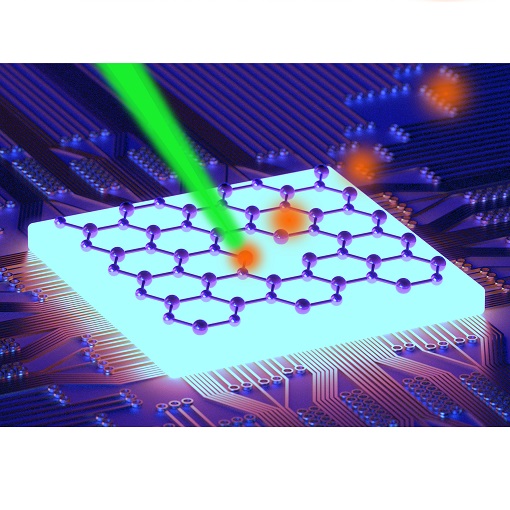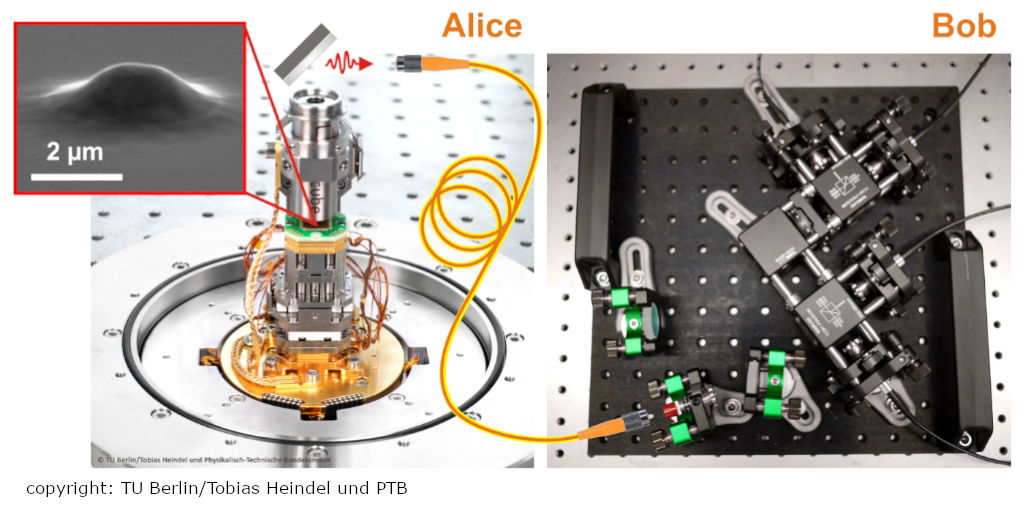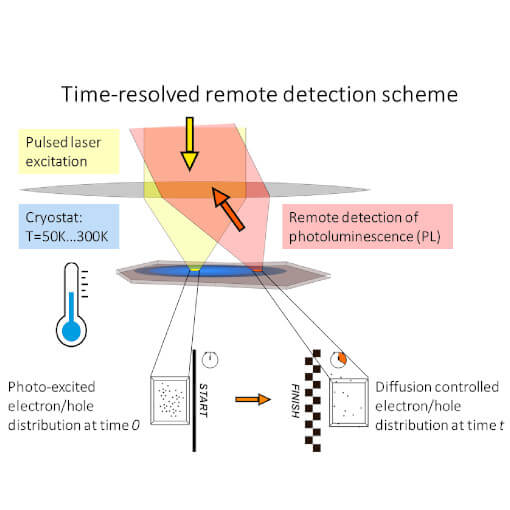Telecom Single-Photon Emitters in Silicon
Recently, silicon emissive centers (SECs) have attracted great attention for their potential as optically accessible spin qubits and single-photon emitters (SPEs). In particular, the isolation of single G and W centers, in the optical telecommunication O-band, has recently been realized in silicon by several groups. In all previous cases, however, single SECs were created uncontrollably in random locations, preventing their scalability.
In their recent study, the Quantum Technologies group of Georgy Astakhov (Helmholtz-Zentrum Dresden-Rossendorf, Germany) reported the controllable and scalable creation of single SECs using focused ion beams (FIB) and CMOS-compatible broad-beam implantation protocols to fabricate telecom SPEs at desired locations on the nanoscale. Single-defect spectroscopy is performed using an all fiber-based confocal PL setup built on a customized optical cryostat (attoDRY800) using an LT-APO IR objective with ANPx311 nanopositioners. Their findings could pave the way toward industrial-scale photonic quantum processors with technology nodes below 100 nm.
This measurement was realized with the attoDRY800.
Further reading:
P. Wan et al., Nature 619, 46 (2023)

Flatlands for Quantum Communication
Single photons are an essential resource for applications in photonic quantum information. Among the many quantum emitter platforms explored to date, the emerging class of 2D material systems has the potential to become a low-cost and scalable platform for engineered quantum light sources. In their recent paper, the group of Tobias Heindel (Technische Universität Berlin, Germany) published in collaboration with Christian Schneider's group (Carl von Ossietzky University, Germany) a study benchmarking single-photon sources based on a WSe2 monolayer for their deployment in quantum-secured communication. In their quantum key distribution testbed, the attoDRY800 optical cryostat provided a reliable platform for cryogenic operation of the atomically-thin quantum light source. Their findings demonstrate the suitability of 2D materials for quantum key distribution, with a performance readily competitive with other material platforms.
This measurement was realized with the attoDRY800.
Further reading:
Gao, T. et al., npj 2D Mater Appl 7, 4 (2023)

3D tunable cavity in ultra low-vibration closed cycle cryostat
Experimental quantum optics is based on controlling the light-matter interaction. This work presents an open Fabry-Pérot cavity optical resonator giving the possibility to locate the region of interest on a solid-state sample as well as in-situ tuning of the cavity degrees of freedom.
In a joint project between an internal research team at attocube and Nanophotonics group of Alexander Högele (Ludwig Maximilian University of Munich, Germany) an open-cavity is realized inside a closed loop attoDRY800 cryostat with precise manipulations using ANPxyz positioners. Tremendous work put into a combination of passive and active vibration damping techniques allow the system to reach an exceptional level of mechanical stability. The researchers have demonstrated the formation of exciton-polaritons in this open-cavity platform with two-dimensional semiconductor and cavity photons as a hallmark of strong light-matter coupling.
The results establish the concept of an open-cavity in a closed-cycle cryostat as a promising quantum hardware tool to advance the field of solid-state quantum optics and cavity quantum electrodynamics.
This measurement was realized with the ANPx101/RES/LT - linear x-nanopositioner, the ANPz101/RES/LT - linear z-nanopositioner, the ANPx311/RES/LT - linear x-nanopositioner, and the attoDRY800.
Further reading:
S. Vadia et al., PRX Quantum 2, 040318 (2021)

Bright Dates: Coupling Single Colloidal Quantum Dots
In the playground of optoelectronics, colloidal quantum dots represent a sort of toy-bricks: single emitters, extremely stable and with high level of control. But what happens when two of those bricks are brought together? Can they stick one onto the other?
To answer this question, the group of Uri Banin (The Hebrew University of Jerusalem, Israel) has performed cryogenic optical measurements in an attoDRY800, revealing that pairs of colloidal quantum dots can couple together, influencing each other. From the optical perspective, this results in a transformation from the simple spectra of the single colloidal quantum dots into a complex emission spectrum of the pairs, constituting "Coupled Colloidal Quantum Dots molecules" where multiple peaks shift with time simultaneously. The authors were then able to assign these simultaneous spectral changes to electrostatic interactions upon charging or discharging of one of the quantum dots. These results indicate that coupled pairs of colloidal quantum dots have the potential to become future building blocks for quantum information and quantum sensing applications.
This measurement was realized with the attoDRY800.
Further reading:
Y. E. Panfil et al. ACS Nano 16, 5566 (2022)

Towards quantum optics devices on a chip
Since photons have low decoherence and inherent capability of low-loss transmission, using single photons as qubits is a promising route towards realization of scalable multi-qubit device that would be able to perform quantum computing and conduct quantum communication. The group of Sven Höfling (University of Würzburg, Germany) studied single photon sources based on In(Ga)As/GaAs quantum dots coupled to waveguides, using an attoDRY800 optical cryostat. They generated highly linearly polarized resonance fluorescence photons with high single photon purity and high indistinguishability, that are within the strict constraints of multi-interferometric applications in quantum optics. These single photon source are scalable and thus suitable for optical circuits for quantum computing and quantum communication on a chip.
This measurement was realized with the attoDRY800.
Further reading:
L. Dusanowski et al., PRL 122, 173602 (2019)

Improving InGaN Quantum Dots as Single-Photon Sources
While quantum dots are generally considered to be excellent candidates as a single-photon sources, their actual performance from this point of view strongly depends on the chemical composition. In the particular case of nitride quantum dots, on one side they can emit single photons even at warm temperatures, up to 350 K, on the other side they are subjected to a significant broadening of their emission. To understand the best way to optimize their performance, the group of Robert Taylor (Oxford University, UK) has extensively investigated the photoluminescence of InGaN quantum dots, discovering that quantum dots grown on a nonpolar plane exhibit a decreased spectral diffusion rate as well as significantly shorter lifetimes compared to polar nitride dots. These findings have been achieved thanks to low-temperature photoluminescence measurements performed in an attoDRY800 cryostat equipped with ANPxyz101 stack.
This measurement was realized with the ANPx101/RES/LT - linear x-nanopositioner, the ANPz102/RES/LT - linear z-nanopositioner, and the attoDRY800.
Further reading:
C. Kocher et al., ACS Photonics 9, 275 (2022)

Quantum control over levitating nanoparticle
The attoDRY800 is not only able to provide an obstruction-free playground for quantum optics experiments, but also ensures extremely clean high-vacuum conditions. These features have brilliantly been exploited by the team of Lukas Novotny (ETH Zurich, Switzerland), which for the first time optically levitated a dielectric nanoparticle in a cryogenic environment and achieved quantum control over its motion. These results have been achieved thanks to the extremely low levels of decoherence provided by the suppression of both gas collisions and emission of blackbody photons in the cryogenic environment, thus allowing to feedback-cool the particle’s motion to the quantum ground state, with a feedback control relying on a cavity-free optical measurement of the particle position that approaches the minimum of the Heisenberg relation to within a factor of two. Furthermore, importance of quantum research and Novotny´s role in it are featured in the annual report of the ETH Board for 2021.
This measurement was realized with the attoDRY800.
Further reading:
F. Tebbenjohanns et al., Nature 595, 378 (2021)

Optimizing quantum emitters in h-BN
Many scientific studies identify hexagonal boron nitride (h-BN) as a versatile material platform for a wide range of applications in nanoscience. Recently, it has also become an attractive material for quantum photonics. Indeed, h-BN is a host for a myriad of bright photoluminescent defects, which have potential as quantum emitters. While the coherent properties of the emitted photons have paramount importance for practical quantum optics application, previous studies of h-BN quantum emitters have revealed that the emissions are broadly affected by spectral diffusion. By employing coherent excitation spectroscopy, the group of Igor Aharonovich (University of Technology Sydney, Australia), has demonstrated that the predominant cause of such a broadening is phonon coupling, this phenomenon being dominant even at the cryogenic temperatures provided by the attoDRY800 cryostat. Additionally, they showed how to minimize the spectral diffusion, by employing excitation powers well below saturation, thus paving the way to the optimization of h-BN for quantum photonics applications.
All the optical measurements of this work have been achieved using an attoDRY800 cryostat, equipped with a 0.82 NA LT-APO objective.
This measurement was realized with the attoDRY800.
Further reading:
S. White et al., Optica 8, 1153 (2021)
Telecom single-photon emitters in silicon
Quantum computing and quantum information processing are currently one of the hottest and best funded topics in physics. Single-photon sources are amongst the most promising candidates for photonic realizations of quantum processors, repeaters and sensors. In their recent paper, the group of Georgy Astakhov (HZDR, Dresden) managed to integrate carbon-based color centers (G center) into off-the-shelf Si wafers, resulting in bright and spectrally stable telecom single-photon sources with emission at about 1.28 µm. The experiments were conducted using an LT-APO objective with ANP nanopositioners in an attoDRY800 optical cryostat at 5.7 K. Their findings pave the way toward integrated photonic devices based on existing, scalable silicon technology combined with telecom wavelength range.
This measurement was realized with the attoDRY800.
Further reading:
M. Hollenbach et al., Optics Express 28, 26111 (2020)
Boosting single-photon quantum key distribution
Engineered quantum light sources emitting single photons on the push of a button are essential components for quantum communication protocols. To maximize the expected secure key and the communication distance for quantum key distribution, the group of Tobias Heindel at the Technische Universität Berlin (Berlin, Germany) developed tools to optimize the performance of quantum key distribution implemented with such engineered single-photon emitters. Exploiting two-dimensional temporal filtering, the expected secure key as well as the communication distance can be optimized. The group implemented their routine in a basic quantum key distribution testbed, comprising a quantum dot device sending single-photon pulses to a four-port receiver analysing the polarisation state of the flying qubits. The single-photon source was mounted on the cold platform of the optical cryostat attoDRY800 as the integration of the platform into an optical table offered the easiest solution for a cold spot on the optical table. Their method further allowed to demonstrate real-time security monitoring via photon-statistics, being an important step towards security certification in quantum communication.
This measurement was realized with the attoDRY800.
Further reading:
T. Kupko et al., npj Quantum Information volume 6, 29 (2020)

Easy-to-use platform for single photon experiments
The efficient generation of single, indistinguishable photons is essential for the development of optical quantum information processing. Specifically, the quest of creating single photons on-demand is limited to certain types of sources and techniques. To achieve this, the company Quandela provides optical accessories and state-of-the-art solid-state source devices emitting millions of quantum-pure photons per second.
Combining attocube's closed cycle cryostat attoDRY800 with Quandela's semiconductor quantum dot emitters guarantees a reliable and easy-to-use state-of-the-art solid-state single photon source for complex experiments and protocols.
With this robust setup it was easily possible to use the single-photon sources for on-demand generation of quantum superpositions of zero, one or two photons [1] speed-up multiphoton experiment on-chip [2] and to proving the technology being ready for large-scale fabrication of identical sources [3]
This measurement was realized with the attoDRY800.


Charge Carrier Mobility in Perovskite thin films
One of today’s main challenges is a pollution-free resource of energy which allows us to limit global climate change. A promising way is the use of solar energy with the optimal photo absorber material. In a joint project, the groups of Achim Hartschuh at the Ludwig Maximilians University (Munich, D) and Pablo Docampo at Newcastle University (Newcastle upon Tyne, UK) presented an optical study about charge carrier transport in a thin film of methylammonium lead iodide - a material which is prototypical for the new class of hybrid perovskites, reaching a solar cell efficiency of more than 22%. Temperature-dependent photoluminescence measurements were performed with the table-integrated closed-cycle cryostat attoDRY800 which allowed for flexible integration of the microscope setup and reliable low-temperature operation.
Photoluminescence measurements indicated a steady decrease of the charge carrier diffusion constant with increasing temperature, see figure. Depending on the structure of the material - tetragonal or orthorhombic crystal phase - the mobility follows a power law dependence as Tm with m = -1.8 +/- 0.1 (tetragonal) or m = -1.2 +/- 0.1 (orthorhombic). The dynamics of the excited charge carriers is in agreement with theoretical models based on a temperature-dependent diffusion constant and several decay channels. Their study opens up the possibility to investigate other material compositions in the same way in the future.
This measurement was realized with the attoDRY800.


Exceptional Drift Stability: Cryogenic Wide-field Microscopy
When dealing with optical microscopy at low temperatures, one pre-requisite of paramount importance is the spatial stability: scarce optical signals such as those from single photon sources often imply long acquisition times, and hence require conditions as stable as possible over extended measurement periods. Temperature fluctuations and gradients, combined with mismatched thermal expansion coefficients among the parts, can jeopardize the acquisition of images over a range of temperatures or longer periods of time.
The LT-APO configuration of the attoDRY800 with cold apochromatic objectives has been expressly designed in order to optimize the stability performance. Overall, this minimizes thermal drifts significantly compared to optics sitting at room temperature - be it in vacuum or outside of the cryostat:
· no measurable drift over 40 h at base temperature, and up to 30 K
· smaller by almost a factor of 20 compared to warm objectives over the full temperature range
Also, vibrations are absolutely no concern since there is no measurable difference between cryocooler ON and OFF configuration even at ultimate resolution.
This measurement was realized with the attoDRY800.



A nanoscale quantum sensor at high pressures
Pressure affects phenomena ranging from the properties of planetary interiors to transitions between quantum mechanical phases. However, the enormous stress gradients generated in high pressure experimental apparatuses, such as the diamond anvil cell, limit the utility of most conventional spectroscopy techniques. To address this challenge, a novel nanoscale sensing platform was independently developed by three groups (given in alphabetic order): the Jean-Francois Roch group (Université Paris-Sud, FR), the Sen Yang group (Chinese University of Hong Kong, CN), and the Norman Yao group (University of California, Berkeley, USA). The researchers used quantum spin defects integrated into an anvil cell to detect minuscule signals under extreme pressures and temperatures with diffraction-limited spatial resolution.
For this purpose, Norman Yao and colleagues utilized the table-integrated closed cycle attoDRY800 cryostat - the ideal platform for precise and rapid temperature control of a diamond anvil cell while offering a large sample chamber and free-beam optical access. The convenience of the closed-cycle cryostat allowed the researchers to publish their results to arXiv just nine months after installation.
This measurement was realized with the attoDRY800.


Non-equilibrium phase transitions in quantum fluids of light
The understanding of many quantum phenomena in solid state physics heavily relies the ability to measure the dispersion relation of the fundamental excitations of the system. In the blossoming field of cavity polariton research, this dispersion relation is directly encoded in the propagation direction of the light emitted by the sample. To decrease the background signal and, therefore, increase the detected signal's quality, thin planar samples are used to perform transmission spectroscopy measurements. The group of Martin Kroner (ETH Zürich, Swizerland) performs such spectroscopy measurements using a table integrated closed cycle cryostat, the attoDRY800, as cold platform for the sample. By allowing for free space optical access to the sample from both sides, the attoDRY800 setup is an ideal platform to carry transmission measurements. In addition, the cold platform’s compactness results in a high stability and leaves most of the optic’s table space for the optical setup.
This measurement was realized with the attoDRY800.
Further reading:
Link to the group's webpage

Polariton dispersion in strong coupling regime
The group of Prof. Atac Imamoglu (ETH Zurich) uses the attoDRY800 for phase contrast microscopy. The video (link below) shows the polariton dispersion in the so-called strong coupling regime, measured via white light transmission. The x-axis represents the in-plane momentum k||, the y-axis the energy E. The time evolution is given by the exciton-cavity detuning. In the inset, the corresponding spectrum at k|| = 0 is shown.
(Data courtesy of Martin Kroner; video created by Thomas Fink and Olivier Faist; Quantum Photonics Group, ETH Zurich)
This measurement was realized with the attoDRY800.
Further reading:
Related video on Youtube
Single Photon Generation with Controlled Polarization from InGaN Quantum Dots
The research groups led by Prof. R. Taylor & Dr. R.A. Oliver in the UK have successfully generated single-photons with polarized light emission and predefined polarization axis at temperatures spanning from around 5 K to above 200 K using InGaN quantum dots. These quantum dots offer several advantages, such as high experimental repetition rates in the range of GHz, and for their growth as a planar structure, a single routine without complex geometrical engineering.
The emission spectra of these quantum dots were characterized using micro-photoluminescence techniques, while the samples were kept cool inside an optical cryostat equipped with attocube positioners. This table top cryostat, the attoDRY800, is able to reach temperatures ranges from below 5 K up to even above 300 K with very good thermal and vibrational stability.
The single-photons generated by these quantum dots are bright enough to allow their optical properties to be measured even above 200 K, a temperature considered to be the Peltier cooling barrier. Hence, this suggests in principle, that these quantum dots could be applied in integrated electronic circuits. And thanks to the achievable polarization control, these quantum dots are good candidates for on-chip polarization encoding in quantum cryptography.
To know more about the work done by Robert Taylor, Rachel Oliver and their research teams, please visit their websites here: https://users.physics.ox.ac.uk/~rtaylor/ and here http://www.gan.msm.cam.ac.uk/directory/oliver
(Data courtesy of R. Taylor, Oxford University)
This measurement was realized with the attoDRY800.



